This is the second part of our material on the strategic planning process. Follow the link to read from the beginning. And if you have already done so, welcome to the next part!
Phase 2: Developing Strategy
In the second phase of strategic planning, the focus shifts to crafting essential elements that define the organization’s direction. This involves formulating mission statements, values, and vision statements that articulate the organization’s purpose and aspirations. Additionally, the development of competitive advantages and organization-wide strategies ensures a comprehensive roadmap for success.
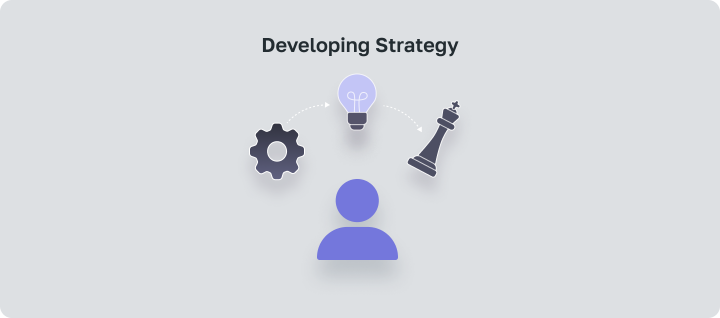
By delving into these critical components of strategic planning, organizations lay the foundation for a cohesive and aligned approach, guiding decision-making and actions at every level for sustainable growth and competitive advantage.
Action Grid
This Action Grid ensures a systematic approach to developing essential elements of strategic planning, fostering alignment, and setting the stage for successful execution in subsequent phases of the strategic planning process.

Step 1: Develop Your Mission Statement

Developing a mission statement is a critical step in defining an organization’s purpose and guiding principles in the strategic plan. Consider the following guide:
- Identify Core Purpose: Articulate the fundamental reason for the organization’s existence.
- Define Key Values: Incorporate core values that reflect the organization’s beliefs and principles.
- Express Aspirations: Convey the desired impact or contribution the organization seeks to make.
A succinct and inspiring mission statement that resonates with stakeholders, provides clarity on organizational purpose, and serves as a guiding beacon for decision-making, strategic planning, and actions.
What is our purpose? Why do we exist? What do we do?
Answering these questions lays the groundwork for strategic planning and crafting a mission statement that succinctly captures the essence of the organization’s purpose and aspirations:
 What is our Core Purpose?
What is our Core Purpose?- Why do we exist?: Identify the fundamental reason for the organization’s existence, emphasizing its broader societal or community impact.
 What Values Define Us?
What Values Define Us?- What do we believe in?: Define the key values that underpin the organization’s culture and decision-making processes.
 What Impact Do We Aspire to Make?
What Impact Do We Aspire to Make?- What do we do?: Convey the desired impact or contribution the organization seeks to achieve, specifying the core activities or services it provides.
Questions to Ask:
Purpose- Question: Why does our organization exist?
- Answer: To address a specific need or contribute to a broader societal or industry goal.
- Question: What principles guide our actions and decisions?
- Answer: Core values such as integrity, innovation, or sustainability.
- Question: What positive change or contribution do we aim to make?
- Answer: The desired societal or community impact through our products, services, or initiatives.
- Question: Who benefits from our existence?
- Answer: Define the primary beneficiaries or stakeholders of the organization.
- Question: What sets us apart from others in our industry or sector?
- Answer: Identify unique qualities, strengths, or approaches that distinguish the organization.
Outcome: A short, concise, concrete statement that clearly defines the scope of the organization.
The outcome of the mission statement development process should be a short, concise, and concrete statement that serves as a leading light for the organization. It must succinctly define the scope of the organization, capturing its core purpose, values, and intended impact.
This statement acts as a unifying force. It provides clarity to internal and external stakeholders about the organization’s purpose. A well-crafted mission statement should resonate, inspire, and serve as a constant reminder of the organization’s fundamental identity, fostering alignment and cohesion across all facets of its operations and strategic planning.
Step 2: Discover Your Values

Embarking on the journey to discover organizational values requires a meticulous examination of the core principles that guide decision-making and actions of strategic planning process. Key questions include:
What do we prioritize?
- Identifying the fundamental principles and priorities that define the organization’s ethical and operational stance.
- Examining the preferred behaviors and interactions within the organizational culture.
- Determining the core beliefs and principles that are non-negotiable for the organization.
How will we behave?
Defining organizational behavior is achieved by outlining and embracing core values that serve as the compass for every action in strategic planning process. These values articulate the expected conduct, attitudes, and ethical standards across all levels of the organization.
By answering the question “How will we behave?” through clearly defined values, the organization establishes a shared understanding of the expected norms and principles. This fosters a cohesive and positive work culture, guiding decision-making and actions toward a collective vision and ensuring consistency in behavior that aligns with the organization’s identity and goals.
Questions to Ask:
Ethical Principles
- Question: What ethical principles should guide our actions?
- Answer: Identifying foundational ethical standards ensures integrity in organizational behavior.
- Question: How do we foster collaboration and teamwork?
- Answer: Defining collaborative values promotes a cooperative and inclusive organizational culture.
- Question: What values encourage a culture of innovation?
- Answer: Identifying values that embrace creativity and adaptability drives innovation.
- Question: How should we prioritize and serve our customers?
- Answer: Defining customer-centric values ensures a focus on delivering value and exceptional service.
- Question: What values support employee well-being and satisfaction?
- Answer: Identifying values that prioritize staff happiness and development fosters a positive work environment.
Outcome: Short list of 5 – 7 core values.
The outcome of the values discovery process should be a concise list of 5 – 7 core values that encapsulate the essence of the organization’s beliefs and principles. These values should serve as a foundation for organizational behavior, guiding decisions, interactions, and initiatives in the strategic planning process.The resulting list should be clear, memorable, and representative of the organization’s identity. This short but powerful compilation ensures a focused and actionable set of values that can be embedded into the organizational culture, outlined in the strategic plan, fostering a shared understanding and commitment among all stakeholders.
Step 3: Casting Your Vision Statement
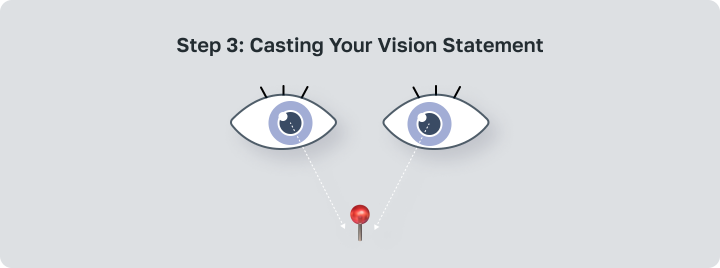
Casting a vision statement involves a thoughtful and strategic formulation in the strategic planning process, addressing key issues to articulate a compelling organizational direction. Focus on:
- Future Aspirations: Envision the desired state or achievements the organization aspires to attain.
- Inspiration and Motivation: Craft language that inspires and motivates stakeholders toward a shared vision.
- Alignment with Mission: Ensuring consistency with corporate vision, values and strategic goals.
A concise, inspirational, and forward-looking vision statement that resonates with stakeholders, providing a clear direction for the organization’s future endeavors, and seamlessly supports your strategic planning.
Where are we going?
Defining the organization’s future direction is achieved through a vision statement, answering the question, “Where are we going?” This statement articulates a compelling and aspirational view of the desired future state. It outlines the organization’s long-term goals, aspirations, and the impact it seeks to make.
By providing a clear and inspirational roadmap, the vision statement guides strategic planning process and decision-making, aligns stakeholders, and motivates collective efforts toward a shared and promising future. It is fostering unity and commitment as the organization navigates toward its envisioned destination.
Questions to Ask:
Future State
- Question: What does the organization aim to achieve in the long term?
- Answer: Articulating the desired future state provides a foundation for the vision statement.
- Question: How will the organization make a positive impact on its stakeholders and the world?
- Answer: Describing the intended impact ensures the vision is purposeful and meaningful.
- Question: How does the vision align with the organization’s core values?
- Answer: Ensuring alignment reinforces consistency and authenticity in the organizational vision.
- Question: What language and imagery will inspire and motivate stakeholders?
- Answer: Crafting inspirational elements ensures resonance and engagement with the vision.
- Question: What specific long-term goals define the envisioned future?
- Answer: Outlining concrete goals provides clarity on the organization’s future trajectory.
Answering these questions contributes to the formation of a vision statement that is clear, inspiring, and strategic planning is aligned with the organization’s purpose and values.
Outcome: A picture of the future.
The outcome of the vision statement development process as a part of the strategic planning process should be a vivid and compelling picture of the future. This concise and inspiring narrative encapsulates the organization’s long-term aspirations, goals, and the positive impact it seeks to make. It acts as a directing signal, providing clarity on the envisioned destination and motivating stakeholders toward a shared and meaningful future.
Step 4: Identify Your Competitive Advantages

Identifying competitive advantages involves a strategic assessment of what sets the organization apart in the market. Key questions and results for strategic planning include:
Distinctive Capabilities
- Question: What unique capabilities, skills, or resources does the organization possess?
- Result: Clear identification of internal strengths that provide a competitive edge.
- Question: How is the organization perceived by customers compared to competitors?
- Result: Understanding of factors that contribute to a positive market perception and differentiation.
- Question: How effectively does the organization innovate and adapt to market changes?
- Result: Recognition of agility and innovation as competitive strengths.
This part of the strategic planning process informs strategies that leverage strengths and capitalize on market differentiators.
What are we best at?
Gaining a competitive edge requires organizations to pinpoint and harness their core strengths. The question, “What are we best at?” directs attention to identifying key competencies, unique capabilities, or specialized resources that differentiate the organization. By strategically leveraging these strengths, the organization positions itself in the market, highlighting superior abilities and qualities.
This strategic planning approach not only enhances competitiveness but also serves as a guiding force for strategic planning process. Ultimately, it ensures the establishment of a unique value proposition, fostering sustainable success in the ever-evolving business landscape.
Questions to Ask:
Distinctive Capabilities
- Question: What unique capabilities or skills set us apart in the market?
- Answer: Identifying distinctive internal strengths provides a competitive advantage.
- Question: How do customers perceive us compared to competitors?
- Answer: Understanding customer perceptions reveals market differentiators.
- Question: In what areas are we operationally efficient and effective?
- Answer: Recognizing operational strengths enhances overall competitiveness.
- Question: How do we innovate and adapt to changing market dynamics?
- Answer: Innovation strategies contribute to a competitive edge in the dynamic business landscape.
By addressing these questions, organizations gain insights into current issues that shape their competitive advantages.
Outcome: A list of 2 or 3 items that honestly express the organization’s foundation for winning.
The outcome of the competitive advantage identification process should be a succinct list of 2 or 3 items that transparently articulate the organization’s foundation for winning. This list encapsulates the core strengths, distinctive capabilities, or unique resources that set the organization apart in the market.
It serves as a strategic toolkit, providing clarity on the pillars that contribute to competitiveness. These identified items become the focal points for positioning the organization strategically, emphasizing its superior attributes.
The outcome ensures a comprehensive understanding of the organization’s unique value proposition, laying the groundwork for targeted strategies and sustained success.
Step 5: Crafting Your Organization-Wide Strategies
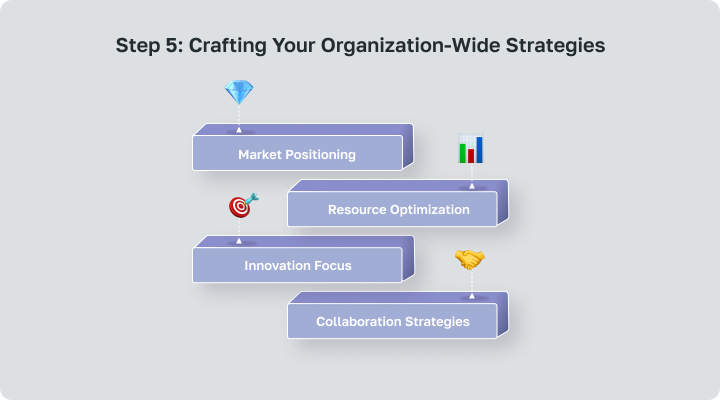
Crafting organization-wide strategies involves a strategic approach to aligning all facets of the business. Key guidance for strategic planning includes:
Strategic Alignment:
- Ensure strategies align with the organization’s mission, vision, and core values.
- Foster collaboration and integration across various departments and teams.
- Strategically allocate resources to initiatives that align with overarching goals.
How will we succeed?
Identifying comprehensive methods of strategic planning process for achieving success involves answering the question, “How will we succeed?” This involves a strategic review of the organization’s strengths, opportunities and competitive advantages. By formulating targeted strategies, allocating resources efficiently, and fostering a culture of innovation and adaptability, the organization sets the groundwork for success.
The emphasis is on aligning all facets of the business with a unified vision, ensuring that every decision and action contributes to the realization of strategic planning. This holistic approach boosts competitiveness, fortifies resilience, and ensures long-term success in an ever-evolving business environment.
Questions to Ask:
Market Positioning
- Question: How can we strategically position ourselves in the market to stand out?
- Answer: Evaluating market positioning ensures a distinct and competitive presence.
- Question: How can we allocate resources efficiently to support our strategic goals?
- Answer: Strategic resource allocation maximizes impact while minimizing waste.
- Question: What strategies foster a culture of innovation and adaptability?
- Answer: Prioritizing innovation ensures relevance and resilience in a dynamic business landscape.
- Question: How can cross-functional collaboration be enhanced to drive organizational goals?
- Answer: Fostering collaboration ensures a cohesive and aligned organizational strategy.
Outcome: Establish the general, umbrella methods you intend to use to reach your vision.
The outcome of the strategy development process is to establish overarching and comprehensive methods that serve as the guiding framework to reach the organization’s vision. This outcome encompasses a set of general strategies, forming an umbrella approach that aligns all facets of the strategic planning process.
These methods should effectively steer the organization toward its envisioned future, ensuring cohesion, resilience, and adaptability. By establishing this strategic framework, the organization sets the stage for coordinated efforts, resource optimization, and sustained progress, fostering a clear path to realizing its vision.
Phase 3: Strategic Plan Development
The strategic plan takes shape through a meticulous strategic planning process. Utilizing insights from the SWOT analysis, the organization defines long-term strategic goals, sets specific objectives, selects Key Performance Indicators (KPIs), and cascades strategies into day-to-day operations.
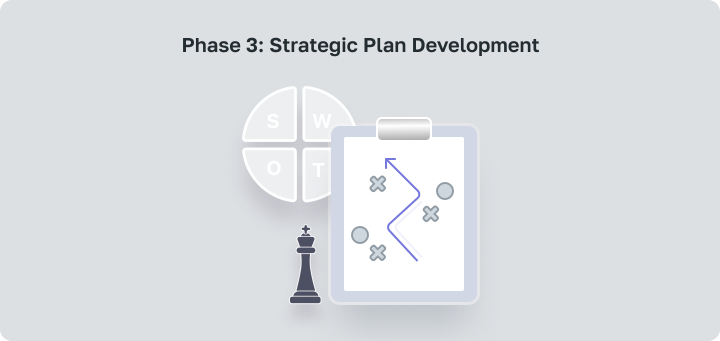
This phase of the strategic planning process marks the translation of high-level aspirations into actionable steps, ensuring a robust and detailed roadmap that aligns with the organization’s mission and vision. The strategic plan becomes a dynamic tool guiding the organization toward its envisioned future while fostering adaptability and performance measurement at every level of the strategic planning process.
Action Grid
Action Grid for Phase 3: Strategic Plan Development:
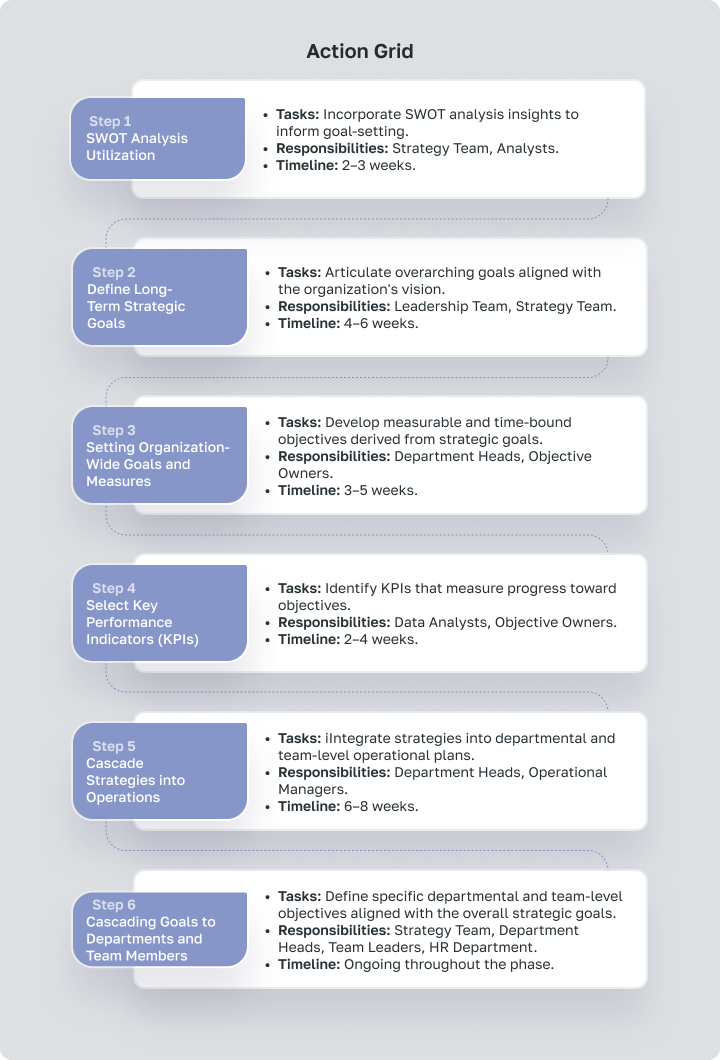
This Action Grid ensures a structured and collaborative approach to the development of the strategic plan, fostering alignment, clarity, and adaptability throughout the organization.
